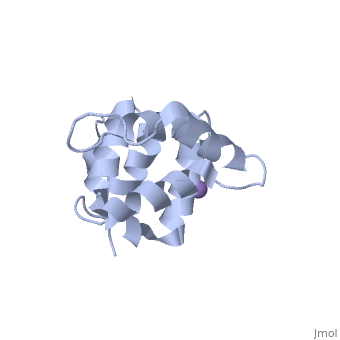Interleukin-1 receptor-associated kinase: Difference between revisions
Jump to navigation
Jump to search
Michal Harel (talk | contribs) No edit summary |
Michal Harel (talk | contribs) No edit summary |
||
| (16 intermediate revisions by 2 users not shown) | |||
| Line 1: | Line 1: | ||
<StructureSection load='2a9i' size='340' side='right' caption='Mouse IRAK4 death domain complex with Mn+2 ion , [[2a9i]]' scene=''> | |||
== Function == | == Function == | ||
'''Interleukin-1 receptor-associated kinase | '''Interleukin-1 receptor-associated kinase''' (IRAK) is a kinase involved in signaling innate immune responses from Toll-like receptors and interleukin-1 receptor-related proteins<ref>PMID:8599092</ref>. | ||
*'''Interleukin-1 receptor-associated kinase 1''' (IRAK1) is a key link in the chain of events initiated by the binding of ligands to IL-R and Toll-like receptor <ref>PMID:30279971</ref>. | |||
*'''Interleukin-1 receptor-associated kinase 2''' (IRAK2) is involved in ER stress-induced cell death<ref>PMID:23724040</ref>. | |||
*'''Interleukin-1 receptor-associated kinase 3''' (IRAK3) is a critical modulator of inflammation in innate immunity<ref>PMID:33382782</ref>. | |||
*'''Interleukin-1 receptor-associated kinase 4''' (IRAK4) has scaffold function in myddosome formation <ref>PMID:30076215</ref>. | |||
== Relevance == | == Relevance == | ||
| Line 9: | Line 12: | ||
== Disease == | == Disease == | ||
IRAK4 deficiency is a disorder which causes recurrent bacterial infections. | IRAK4 deficiency is a disorder which causes recurrent bacterial infections. | ||
</StructureSection> | |||
==3D structures of interleukin-1 receptor-associated kinase== | |||
Updated on {{REVISIONDAY2}}-{{MONTHNAME|{{REVISIONMONTH}}}}-{{REVISIONYEAR}} | |||
{{#tree:id=OrganizedByTopic|openlevels=0| | |||
*IRAK1 | |||
**[[6bfn]] – hIRAK1 residues 194-530 - human<br /> | |||
*IRAK2 | |||
**[[3mop]] – hIRAK2 DEATH domain + hIRAK4 DEATH domain + MYD88 <br /> | |||
*IRAK3; Domains – DEATH 4-106; pseudokinase 145-454 | |||
**[[5uke]] – hIRAK3 DEATH domain (mutant) - NMR<br /> | |||
**[[6ziw]] – hIRAK3 pseudokinase domain + ATPgS <br /> | |||
**[[6ruu]] – hIRAK3 pseudokinase domain <br /> | |||
*IRAK4 kinase domain residues 30-336; DEATH domain residues 4-106 | |||
[[2nru]], [[2nry]], [[2oib]], [[2o8y]] – hIRAK4 kinase domain | **[[2nru]], [[2nry]], [[2oib]], [[2o8y]], [[4rmz]] – hIRAK4 kinase domain <br /> | ||
[[4u97]], [[4u9a]] - hIRAK4 kinase domain (mutant)<br /> | **[[4u97]], [[4u9a]] - hIRAK4 kinase domain (mutant)<br /> | ||
[[ | **[[2oic]], [[4xs2]] - hIRAK4 kinase domain + staurosporine<br /> | ||
[[ | **[[4y73]], [[4yo6]], [[4yp8]], [[4ztl]], [[4ztm]], [[4ztn]], [[5kx7]], [[5kx8]], [[5t1s]], [[5t1t]], [[5uiq]], [[5uir]], [[5uis]], [[5uit]], [[5uiu]], [[6f3d]], [[6f3e]], [[6f3g]], [[6f3i]], [[6lxy]], [[6n8g]], [[6o8u]], [[6o94]], [[6o95]], [[6o9d]], [[6thw]], [[6thx]], [[6thz]], [[6ti8]], [[6tia]], [[6uya]], [[6vql]], [[7c2v]], [[7c2w]], [[7og1]], [[7qg2]], [[7qg3]], [[7qg5]], [[8dks]] - hIRAK4 kinase domain + inhibitor<br />, | ||
[[ | **[[5w84]], [[5w85]], [[5k72]], [[5k75]], [[5k76]], [[5k7g]], [[5k7i]], [[6ega]], [[6eg9]], [[6egd]], [[6ege]], [[6egf]], [[6mom]], [[6rfi]], [[6rfj]] - hIRAK4 residues 154-460 + inhibitor<br /> | ||
[[2oid]] - hIRAK4 kinase domain + AMPPNP<br /> | **[[2oid]] - hIRAK4 kinase domain + AMPPNP<br /> | ||
[[3mop]] - hIRAK4 DEATH domain + hIRAK2 DEATH domain + MYD88 | **[[3mop]] - hIRAK4 DEATH domain + hIRAK2 DEATH domain + MYD88<br /> | ||
**[[1wh4]] – mIRAK4 DEATH domain – mouse – NMR<br /> | |||
**[[2a9i]] - mIRAK4 DEATH domain<br /> | |||
}} | |||
== References == | == References == | ||
<references/> | <references/> | ||
[[Category:Topic Page]] | [[Category:Topic Page]] | ||
Latest revision as of 14:32, 7 July 2024
FunctionInterleukin-1 receptor-associated kinase (IRAK) is a kinase involved in signaling innate immune responses from Toll-like receptors and interleukin-1 receptor-related proteins[1].
RelevanceIRAK4 is involved in early recognition of pathogens and the initiation of inflammation when fighting infection. DiseaseIRAK4 deficiency is a disorder which causes recurrent bacterial infections. |
| ||||||||||
3D structures of interleukin-1 receptor-associated kinase3D structures of interleukin-1 receptor-associated kinase
Updated on 07-July-2024
ReferencesReferences
- ↑ Cao Z, Henzel WJ, Gao X. IRAK: a kinase associated with the interleukin-1 receptor. Science. 1996 Feb 23;271(5252):1128-31. PMID:8599092
- ↑ Singer JW, Fleischman A, Al-Fayoumi S, Mascarenhas JO, Yu Q, Agarwal A. Inhibition of interleukin-1 receptor-associated kinase 1 (IRAK1) as a therapeutic strategy. Oncotarget. 2018 Sep 7;9(70):33416-33439. PMID:30279971 doi:10.18632/oncotarget.26058
- ↑ Benosman S, Ravanan P, Correa RG, Hou YC, Yu M, Gulen MF, Li X, Thomas J, Cuddy M, Matsuzawa Y, Sano R, Diaz P, Matsuzawa S, Reed JC. Interleukin-1 receptor-associated kinase-2 (IRAK2) is a critical mediator of endoplasmic reticulum (ER) stress signaling. PLoS One. 2013 May 28;8(5):e64256. PMID:23724040 doi:10.1371/journal.pone.0064256
- ↑ Nguyen TH, Turek I, Meehan-Andrews T, Zacharias A, Irving H. Analysis of interleukin-1 receptor associated kinase-3 (IRAK3) function in modulating expression of inflammatory markers in cell culture models: A systematic review and meta-analysis. PLoS One. 2020 Dec 31;15(12):e0244570. PMID:33382782 doi:10.1371/journal.pone.0244570
- ↑ De Nardo D, Balka KR, Cardona Gloria Y, Rao VR, Latz E, Masters SL. Interleukin-1 receptor-associated kinase 4 (IRAK4) plays a dual role in myddosome formation and Toll-like receptor signaling. J Biol Chem. 2018 Sep 28;293(39):15195-15207. PMID:30076215 doi:10.1074/jbc.RA118.003314
